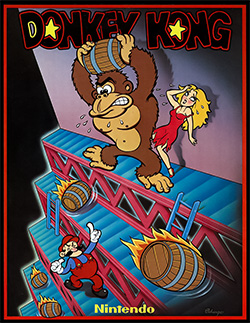
Jeff Minter is an English video game designer and programmer who often goes by the name Yak. He is the founder of software house Llamasoft and has created dozens of games during his career, which began in 1981 with games for the ZX80. Minter's games are shoot 'em ups which contain titular or in-game references demonstrating his fondness of ruminants. Many of his programs also feature something of a psychedelic element, as in some of the earliest "light synthesizer" programs including Trip-a-Tron.
The video game crash of 1983 was a large-scale recession in the video game industry that occurred from 1983 to 1985, primarily in the United States. The crash was attributed to several factors, including market saturation in the number of video game consoles and available games, many of which were of poor quality. Waning interest in console games in favor of personal computers also played a role. Home video game revenue peaked at around $3.2 billion in 1983, then fell to around $100 million by 1985. The crash abruptly ended what is retrospectively considered the second generation of console video gaming in North America. To a lesser extent, the arcade video game market also weakened as the golden age of arcade video games came to an end.

An amusement arcade, also known as a video arcade, amusements, arcade, or penny arcade, is a venue where people play arcade games, including arcade video games, pinball machines, electro-mechanical games, redemption games, merchandisers, or coin-operated billiards or air hockey tables. In some countries, some types of arcades are also legally permitted to provide gambling machines such as slot machines or pachinko machines. Games are usually housed in cabinets.
Shoot 'em ups are a sub-genre of action games. There is no consensus as to which design elements compose a shoot 'em up; some restrict the definition to games featuring spacecraft and certain types of character movement, while others allow a broader definition including characters on foot and a variety of perspectives.

Frogger is a 1981 arcade action game developed by Konami and published by Sega. In North America, it was distributed by Sega/Gremlin. The object of the game is to direct five frogs to their homes by dodging traffic on a busy road, then crossing a river by jumping on floating logs and alligators.
The golden age of arcade video games was the period of rapid growth, technological development, and cultural influence of arcade video games from the late 1970s to the early 1980s. The release of Space Invaders in 1978 led to a wave of shoot-'em-up games such as Galaxian and the vector graphics-based Asteroids in 1979, made possible by new computing technology that had greater power and lower costs. Arcade video games switched from black-and-white to color, with titles such as Frogger and Centipede taking advantage of the visual opportunities of bright palettes.

Donkey Kong is a 1981 arcade video game developed and published by Nintendo. As Mario, the player runs and jumps on platforms and climbs ladders to ascend a construction site and rescue Pauline from a giant gorilla, the titular Donkey Kong. It is the first game in the Donkey Kong series as well as Mario's first appearance in a video game.

Whac-A-Mole is an arcade game. It was created in 1975 by the amusements manufacturer TOGO in Japan, where it was originally known as Mogura Taiji or Mogura Tataki.
Fueled by the previous year's release of the colorful and appealing Pac-Man, the audience for arcade video games in 1981 became much wider. Pac-Man influenced maze games began appearing in arcades and on home systems. Pac-Man was the highest grossing video game for the second year in a row. Nintendo's Donkey Kong defined the platform game genre, while Konami's Scramble established scrolling shooters. The lesser known Jump Bug combined the two concepts into both the first scrolling platform game and the first platform shooter. Other arcade hits released in 1981 include Defender, Frogger, and the Galaxian sequel Galaga.

Stern Electronics Inc. v. Kaufman, 669 F.2d 852, is a legal case in which the United States Court of Appeals Second Circuit held that Omni Video Games violated the copyright and trademark of Scramble, an arcade game marketed by Stern Electronics. The lawsuit was due to a trend of "knock-off" video games in the early 1980s, leading to one of the earliest findings of copyright infringement for a video game, and the first federal appellate court to recognize a video game as a copyrighted audiovisual work.
A beat 'em up is a video game genre featuring hand-to-hand combat against a large number of opponents. Traditional beat 'em ups take place in scrolling, two-dimensional (2D) levels, while a number of modern games feature more open three-dimensional (3D) environments with yet larger numbers of enemies. The gameplay tends to follow arcade genre conventions, such as being simple to learn but difficult to master, and the combat system tends to be more highly developed than other side-scrolling action games. Two-player cooperative gameplay and multiple player characters are also hallmarks of the genre. Most of these games take place in urban settings and feature crime-fighting and revenge-based plots, though some games may employ historical, science fiction or fantasy themes.

005 is a 1981 arcade video game by Sega. They advertised it as the first of their RasterScan Convert-a-Game series, designed so that it could be changed into another game in minutes "at a substantial savings".

Bloody Wolf, released in Europe as Battle Rangers, is a run and gun arcade game released by Data East in 1988. Two commandos take on an entire army with many weapons, and defeat bosses to advance levels.

Sky Skipper is a 1981 arcade video game by Nintendo. The player pilots a biplane and must save animals and a royal family from gorillas holding them captured. This is done by dropping bombs on the gorillas to knock them out and unlock the cages, then diving down towards the cages to pick up the freed characters before the gorillas lock the cages again. An Atari 2600 port was released in 1983.

Cube Quest is a shoot 'em up arcade laserdisc game by American company Simutrek released in 1983. It was primarily designed and programmed by Paul Allen Newell, who previously wrote some Atari 2600 games. It was introduced at Tokyo's Amusement Machine Show in September 1983 and then the AMOA show the following month, before releasing in North America in December 1983.

Turbo is a racing game released in arcades in 1981 by Sega. Designed and coded by Steve Hanawa, the game received positive reviews upon release, with praise for its challenging and realistic gameplay, 2.5D color graphics with changing scenery, and cockpit sit-down arcade cabinet. It topped the monthly Play Meter arcade charts in North America and ranking highly on the Game Machine arcade charts in Japan.
The 1980s was the second decade in the industry's history. It was a decade of highs and lows for video games. The decade began amidst a boom in the arcade business with giants like Atari still dominating the American market since the late-1970s. Another, the rising influence of the home computer, and a lack of quality in the games themselves led to an implosion of the video game market that nearly destroyed the industry in North America. It took home consoles years to recover from the crash, but Nintendo filled in the void with its Nintendo Entertainment System, reviving interest in consoles. Up until this point, most investors believed video games to be a fad that has since passed. In the remaining years of the decade, Sega ignites a console war with Nintendo, developers that had been affected by the crash experimented with the more advanced graphics of the PC, and Nintendo released the Game Boy, which would become the best-selling handheld gaming device for the next two-decades. Other consoles releases in the decade included the Intellivision, TurboGrafx-16 and Sega Genesis. Notable games of the 1980s included Super Mario Bros., Duck Hunt, Metroid, Elite, Tetris, SimCity, Galaga, Contra,Pitfall!, Frogger, Mike Tyson's Punch-Out!!, Defender, Mega Man 2, The Legend of Zelda, Castlevania, Ghosts 'n Goblins, Super Mario Bros. 2, Bubble Bobble, Double Dragon,Final Fight, Ninja Gaiden, Adventure, Joust, Robotron: 2084, Pac-Man, Dig Dug, Arkanoid,Populous, Zelda II: The Adventure of Link,R-Type, Donkey Kong, Centipede, Super Mario Bros. 3, Prince of Persia, Sid Meier's Pirates!, Where in the World Is Carmen Sandiego?,Gauntlet, Strider, Tron,Dragon's Lair, Golden Axe, Ms. Pac-Man, Out Run, Dungeon Master,Final Fantasy, Altered Beast, Shinobi, Tempest, Lode Runner, Super Mario Land, Battlezone,Dragon Quest, Ultima IV: Quest of the Avatar, Pole Position, and Marble Madness.
"Less Than" is a song by American industrial rock band Nine Inch Nails from their EP Add Violence (2017). It was released on July 13, 2017, becoming the band's first single since "Everything" in August 2013. The song's music video alludes to the video game Polybius, an urban legend about a video game used to mine information from people for the government. It peaked at No. 10 on the Billboard US Mainstream Rock Songs chart.

Polybius is a 2017 shoot 'em up video game developed and published by Llamasoft. It was released in May 2017 for the PlayStation 4, with PlayStation VR support available. A version for Windows was released in December 2018. The game takes its name and inspiration from the fictitious 1981 arcade game Polybius. It is also inspired by games like TxK and aims to induce the psychological state of flow. It was positively received by critics.














